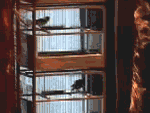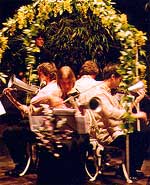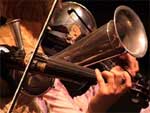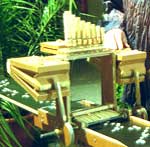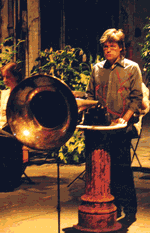 | |||||||

|
mechanical landscape with bird a stroh project from aleks kolkowski |
|
|
Set in a luxurious garden on stage in a reenactment of the dawn, eight singing canaries (Belgian Waterslagers & Spanish Timbrados) are accompanied by a serinette (bird-organ) and a string quartet of horned ‘Stroh’ violins. During the performance, the canaries’ song is also recorded & played back on a pair of wax cylinder phonographs. The string quartet is seated on a carousel and as the musicians play, their horns facing outwards, the carousel slowly turns in sympathy with the hand-cranked rotations from the serinette and phonographs, producing a gentle phasing effect. The Serinette was invented in the 1700s to entice canaries (French serin) to sing and to teach them popular melodies of the day. As it carries its music on a cylinder, it is also considered to be the 18th century forerunner to the phonograph. The serinette used in this project was designed and built by Martin Riches, and is an exploded version intended as a concert instrument: the claves, bellows and pipes are all clearly visible. The music played, as is that for the string quartet, is largely based on the song of the waterslager canary, and is composed in such a way as to stimulate the birds to sing by playing them elements of their own song. The Stroh violin was patented by J.M.A Stroh in 1899 and is the first musical instrument specifically designed for recording. Characterised by large aluminium trumpet horn, and a revolutionary mechanical amplification system, it was widely employed in the early acoustic sound studios until the advent of electrical sound recording in the mid 1920s. The instruments used in this project are from my own collection. This performance pays homage to the once popular genre of recorded birdsong with musical accompaniment, particularly the work of Karl Reich (1885-1970) from Bremen, Germany. His 1910 Record Made by a Captive Nightingale for Deutsche Grammophon, was the first published recording of a bird. During the 1920s Reich went on to produce a series of records featuring singing birds enthusiastically responding to the background strains of popular classics, waltzes and german folk music, played by an ensemble or soloist. A recurring feature has been the use of wax cylinder phonograph recording and playback in live performance. Instruments and voices are confronted with their wax effigies in sound. The fragility, and faintness of these acoustic recordings could not be further removed from the over-amplified, hyper-realism of our digital age. Rather than a virtual copy, they are a listening experience akin to a faded but intense memory. The sound engraving process envelops the recording with a patina of noise, a raw substance through we strain to hear the past. By ‘aging’ the sound in this way, we can play with time in its retrospective sense. The modern day quest for digital perfection and noise reduction in audio appliances is paralleled by the rise of distortion and noise making devices and software. In an age where noise is elevated to the status of art, the phonograph once again has something to offer us. Founded in 2002 by Aleksander Kolkowski, Recording Angels is a series that examines our relationships to recorded sound using antiquated home-recording devices such as phonographs and acetate record cutters in performances and installations. For further information, CDs & DVDs, please contact us via the link. Mechanical Landscape with Bird was commissioned by the MärzMusik Festival - Berliner Festspiele, and premiered on 28.3.2004 at the sophiesaele, Berlin, Germany. Composition, Direction & Phonographs - Aleksander Kolkowski Bird Trainer - Helmut Mossmann Serinette Construction & Operation - Martin Riches Kairos Quartett - Wolfgang Bender, Chatschatur Kanajan (vlns), Simone Heilgendorff (vla), Claudius von Wrochem (c) Garden Design & Costumes - Anja Fuchs Stage Technician & Carousel Operator - Zolle |
 |
